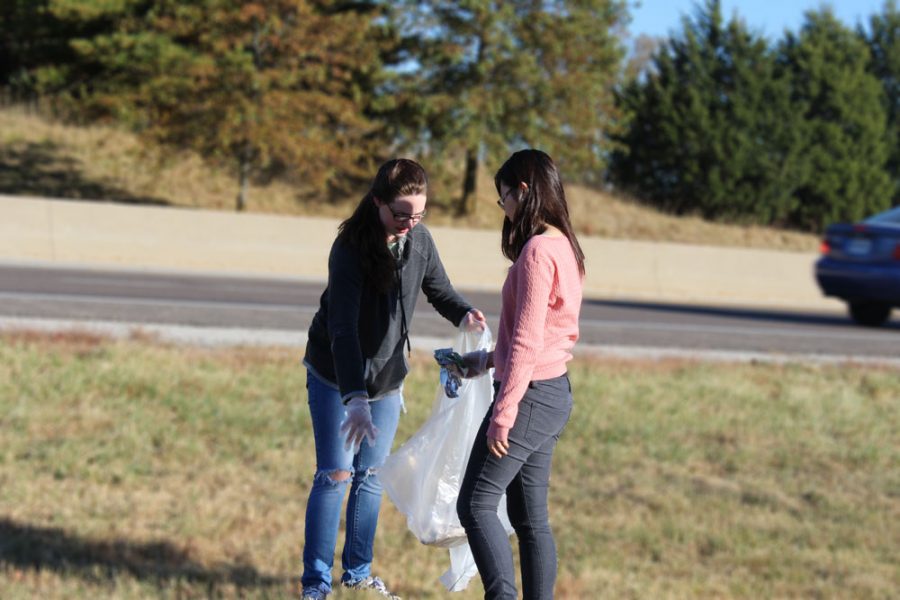Around five to 20 percent of people in the United States contract the influenza virus every year between December and February, according to new statistics from the Center for Disease Control. This year, however, the CDC said the combination of a stronger strain of the virus and a mostly ineffective vaccine have caused an unnaturally high number of people to fall ill, with over 37,000 cases of laboratory-positive influenza diagnosed in the state of Missouri since the week of Oct. 4.
While hospitals and pediatricians often see more patients during flu season, school nurses often see an increase in the number of students sent home with flu-like symptoms during the winter months. Nurse Tammy Adkins said every year RBHS seems to have its own flu season in which many students are sent home sick during a short period of time.
“We don’t see a lot of fevers normally, but in flu season, that’s when we really see them the most,” Adkins said. “A lot of times we will go weeks without fevers, but then when we hit flu season or when flu season has hit Rock Bridge, we will have several fevers in a day or a week.”
Unlike the flu season in the United States, however, Adkins said the period of time when more students fall ill at school is much shorter, though she still sees an average of 35 to 45 students in her office each day.
“There will be times that we have sort of a big peak and upswing kind-of-thing, but it’s not during the whole flu season,” Adkins said. “It’s just usually in one or two weeks. You might see the peaks. We ebb and flow a lot during the year.”
Senior Sydney Griggs said she does not visit the nurse’s office often, but when she has visited the nurse, Adkins has been kind and helpful in taking care of Griggs’ ailments.
“I, honestly, don’t ever go to the nurse,” Griggs said. “I’ve only been probably once out of all of high school, and whenever I went, I had a great experience. [Adkins] was really cool.”
Unlike Griggs, junior Mickey Jamieson said he tends to go to the nurse’s office more often than most students.
“It depends on the year,” Jamieson said. “Last year, I didn’t really go to the nurse, but this year I’ve been at least two or three times. It’s been a rather difficult year.”
Compared to his past experiences with the nurse, Jamieson said the nurse at RBHS is much more helpful and better able to take care of the students than the nurses at his elementary and middle schools.
“Here at Rock Bridge, it seems like they’ve got a little bit more to offer because I know I can leave medicine here if I need to,” Jamieson said. “I went to a private school when I was in elementary school and they didn’t seem to offer as much. You could go in there and get your temperature checked out…but that was about the extent of what they could do.”
Though the nurses’ policies remains similar across the Columbia Public Schools district, Adkins said she understands how the nurses’ offices at different grade levels can seem to be less helpful than those at RBHS. She said the reason for this is the greater level of responsibility that can be placed on students as they get older.
“Some of that is philosophy. Obviously, as the school nurse … kids being healthy and staying in school is part of my job,” Adkins said. “But, when you get to high school level, you guys are much more involved in the choices that are happening, so you need to be able to say, ‘I don’t feel good. I need to go home,’ or ‘No, I’m going to work through this…’ At this age, you’re the one that bears the consequences of not going to school.”
Nevertheless, Jamieson said he believes policies in the nurses’ offices across the school district should be more relaxed so students are able to leave if they are not feeling well, especially around flu season.
“Fevers come and go, but during flu season … if they are running a fever and it could potentially be the flu, I think it would be in the best interest of the school to send them home,” Jamieson said. “They don’t want to have anyone else catching the flu.”
Griggs disagrees and said the nurse is helpful in caring for sick students already. She said she believes they shouldn’t need to change their policies simply to accommodate an annual spike in students catching the flu.
“I think they should just keep doing what they were doing because everyone gets sick, and you’re going to have rough seasons and seasons that are better,” Griggs said. “I think if they just stay on top of the kids and make sure they really are sick and are going home for the right reasons then I think they should just continue with their protocol.”
Overall, Adkins said the nurse’s office already follows a specific policy for sending students home sick, such as when they have a fever over 100 degrees or an unexplained rash. She said these policies will not change around flu season and will continue to be used year-round for the foreseeable future.
“Our guidelines are our guidelines,” Adkins said. “We just send more kids home with fevers during flu season.”
By Nicole Schroeder



















































































